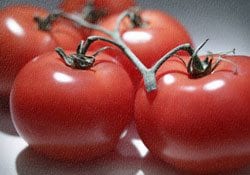

Avacados are rich in protein, contain all essential amino acids and, like sweet potatoes, contain carotenoids.
| Cook tomatoes to best absorb their cancer-fighting phytonutrient, lycopene. |
Experts at Dana-Farber highlight five cancer-fighting foods with easy-to-make recipes
Confusing and conflicting health claims can make it a challenge to select healthy food, but the good news is that there are many nutritious options.
“There are so many ‘good-for-you’ foods to choose from that the list could be a mile long,” says Stacy Kennedy, MPH, RD, CSO, LDN, a nutritionist at Dana-Farber Cancer Institute. “But if I had to pick just five, I would start in the produce aisle of the grocery store.”
Remember: If it comes from the ground and can stain a shirt, you want to be eating it.
“The key is color,” says Kennedy. “That is where the phytonutrients, or cancer-fighting properties, can be found. They help protect the produce and can also be beneficial for humans by strengthening the immune system.”
Here is a list of five of Kennedy’s favorite foods, as well as easy-to-make recipes for each. All can be found on the Dana-Farber Nutrition Services web page.
1.Kale
Kale may be the new “it” food, but long before it was popular, it was one of Kennedy’s favorites. “Kale is one of my go-to choices, because it’s rich in a phytonutrient called indoles, which stimulates liver detoxification and helps fight cancer,” says Kennedy. Indoles are found in the rich, dark green color of kale. Other members of the cruciferous family include broccoli, cabbage and brussel sprouts.
The American Cancer Society suggests consuming one serving of cruciferous vegetables a day, and studies show people who have diets rich in these vegetables have been found to have lower incidences of lung cancer, prostate cancer and stomach cancer.
Kale that is cooked by steaming also may have cholesterol-lowering benefits. Try it in a hearty seafood stew with tomatoes, saffron and kale.
2. Tomatoes
“Tomatoes are a great food because they are rich in a phytonutrient called lycopene, which has been associated with a reduced risk of prostate cancer,” explains Kennedy.
Tomatoes are available year-round in the supermarket, but when they are in season, try to buy them at local farm stands. That’s when they are at their nutritional peak.
A tip for getting the most nutritional value from tomatoes is to buy local, make them into a sauce, and freeze it to use year-round. The lycopene is best absorbed when the tomato is cooked. Including a healthy fat, like olive oil or avocado, helps pack a more nutritional punch. Try them fresh in this dish of angel hair pasta with tomatoes and avocado.
3. Sweet Potatoes
Sweet potatoes and yams are other foods that should be enjoyed year-round. They are rich in a phytonutrient called carotenoids. “As little as two servings a day of carotenoids have been shown to help reduce the risk of breast cancer, lung cancer and ovarian cancer,” says Kennedy.
What other foods are rich in carotenoids? Think orange like carrots, acorn or butternut squash, and pumpkin.
Phytonutrients like carotenoids are available in pill form, but Kennedy warns that they do not have the same protective properties as those found in whole foods and may even cause harm in certain individuals.
To get the healthiest boost, Kennedy says it is best to eat the food in its whole form. One of her favorites is a roasted vegetable salad.
4. Apples
Studies suggest that eating at least one apple a day can help prevent throat, mouth, colon, lung and possibly breast cancer. Besides being crisp, sweet and juicy, apples contain quercetin, a nutrient that protects the cell’s DNA from damage that could lead to the development of cancer.
“It’s best to choose organic, when possible, and eat them raw and with the skin on,” says Kennedy. “That’s where many of the nutrients are found.”
5. Quinoa (keen-wah)
Although it may not be found in the produce aisle, quinoa is a great source of protein. It’s naturally gluten-free and often called an ancient grain because it’s been grown for thousands of years. Quinoa is actually a seed that can be ground into flour.
It is considered a complete protein because it contains all nine essential amino acids. Quinoa is also rich in fiber and minerals like iron, magnesium and calcium, plus phytonutrients like quercetin.
Quinoa is a nice alternative to protein-rich foods like meat and fish. Other alternatives include lentils, beans, nuts, seeds, whole grains and dark green, leafy vegetables.
Angel Hair Pasta with Tomatoes and Avocado
Ingredients:
• 8 ounces uncooked angel hair pasta
• 2 tablespoons olive or vegetable oil
• 1/2 large avocado cut into cubes
• 4 medium tomatoes
• Salt/pepper
Directions:
• Cook and drain pasta as directed
• In a 3-quart saucepan, over medium heat, heat oil with avocado and tomatoes.
• Toss vegetables mixture and pasta. Sprinkle with salt/pepper or garlic to taste.
Yield: 6 servings
Recipe courtesy of Dana-Farber cancer institute.






